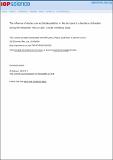The influence of droplet size and biodegradation on the transport of subsurface oil droplets during the Deepwater Horizon: a model sensitivity study
Author(s)
North, Elizabeth W; Thessen, Anne E; Schlag, Zachary; He, Ruoying; Socolofsky, Scott A; Masutani, Stephen M; Peckham, Scott D; Adams, E. Eric; ... Show more Show less
DownloadNorth-2015-The influence of dro.pdf (2.684Mb)
PUBLISHER_CC
Publisher with Creative Commons License
Creative Commons Attribution
Terms of use
Metadata
Show full item recordAbstract
A better understanding of oil droplet formation, degradation, and dispersal in deep waters is needed to enhance prediction of the fate and transport of subsurface oil spills. This research evaluates the influence of initial droplet size and rates of biodegradation on the subsurface transport of oil droplets, specifically those from the Deepwater Horizon oil spill. A three-dimensional coupled model was employed with components that included analytical multiphase plume, hydrodynamic and Lagrangian models. Oil droplet biodegradation was simulated based on first order decay rates of alkanes. The initial diameter of droplets (10–300 μm) spanned a range of sizes expected from dispersant-treated oil. Results indicate that model predictions are sensitive to biodegradation processes, with depth distributions deepening by hundreds of meters, horizontal distributions decreasing by hundreds to thousands of kilometers, and mass decreasing by 92–99% when biodegradation is applied compared to simulations without biodegradation. In addition, there are two- to four-fold changes in the area of the seafloor contacted by oil droplets among scenarios with different biodegradation rates. The spatial distributions of hydrocarbons predicted by the model with biodegradation are similar to those observed in the sediment and water column, although the model predicts hydrocarbons to the northeast and east of the well where no observations were made. This study indicates that improvement in knowledge of droplet sizes and biodegradation processes is important for accurate prediction of subsurface oil spills.
Date issued
2015-02Department
Massachusetts Institute of Technology. Department of Civil and Environmental EngineeringJournal
Environmental Research Letters
Publisher
IOP Publishing
Citation
North, Elizabeth W, E Eric Adams, Anne E Thessen, Zachary Schlag, Ruoying He, Scott A Socolofsky, Stephen M Masutani, and Scott D Peckham. “ The Influence of Droplet Size and Biodegradation on the Transport of Subsurface Oil Droplets During the Deepwater Horizon Spill: a Model Sensitivity Study .” Environmental Research Letters 10, no. 2 (February 1, 2015): 024016.
Version: Final published version
ISSN
1748-9326